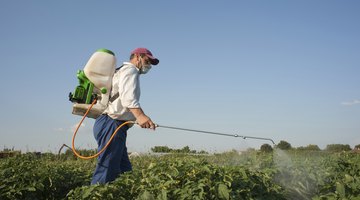About Sevin Insecticide
A broad-spectrum pesticide, Sevin controls a wide range of insects and other pests in vegetable patches, ornamental gardens and orchards. Its active chemical, carbaryl, affects nervous systems.

Available to home gardeners as ready-to-use liquid, liquid concentrate, wettable powder, dust and granules, Sevin should be used with caution to protect beneficial insects, wildlife, people and pets. Wear safety goggles, long pants, a long-sleeved shirt and gloves when applying Sevin for personal protection.
How It Works
Sevin works by preventing nerves from functioning. By preventing the destruction of a nerve chemical called acetylcholine, Sevin affects insects' central nervous systems, causing convulsions, paralysis and death, and in other animals it affects the interactions between nerves and muscles. An off-white to pale yellow liquid with a mild odor, Sevin has a short-term residual effect. Carbaryl breaks down by half into an inactive chemical in about 3 1/2 days on plant leaves, and four to 72 days in the soil, depending on the conditions. It breaks down more quickly in flooded, aerated and sandy soils. Sevin is a trademarked product produced by GardenTech Inc.
Targeted Pests
Sevin controls most pests. Mosquitoes, psyllids, borers, earwigs, grasshoppers, moths, beetles, ants, ticks, cockroaches, spider mites, snails and slugs are some pests controlled by Sevin products. Juvenile forms of pests are also affected, such as grubs, caterpillars, worms and maggots. Pests die through eating Sevin, so it must be applied where the targeted pests congregate: on bark, leaves and stems or on the soil around the base of plants. Sevin also kills beneficial insects such as ladybugs, lacewings and hoverflies, and honeybees, bumble bees, leaf cutter bees and alkali bees.
Application Rates
Application rates and methods vary among Sevin products and pests. For example, a 22.5 percent carbaryl product should be diluted at a rate 1 1/2 to 3 fluid ounces per gallon of water to control armyworm, chinch bugs, corn rootworm, corn earworm, flea beetles and other pests in 1,000 square feet of corn (Zea mays), which is an annual plant. To control ants, chiggers, crickets, grasshoppers, lawn moths, millipedes and other lawn pests, spread a 6.3 percent carbaryl granular Sevin product at a rate of 2.2 to 3 pounds per 1,000 square feet. Alternatively, apply Sevin products according to the manufacturer's instructions.
Precautions For Use
Taking precautions when using Sevin improves its efficiency and helps protect other organisms. Don't apply Sevin if rain is forecast, and turn off automatic sprinklers to prevent the pesticide from being washed off plants. Spray only the affected areas of plants, and only in the early morning or at dusk, when bees aren't foraging. Sevin is toxic to mammals, several fish species and aquatic invertebrates, and also to crabs, shrimp and oysters, so don't use it in areas accessible to children or pets or near water. Symptoms of carbaryl poisoning include stinging, burning, swollen eyes, a burning or sore throat, sweating, chest tightness and wheezing, nausea, retching and vomiting. Store Sevin in a cool, dry place out of the reach of children and animals.
The Drip Cap
- A broad-spectrum pesticide, Sevin controls a wide range of insects and other pests in vegetable patches, ornamental gardens and orchards.
- Its active chemical, carbaryl, affects nervous systems.
- Pests die through eating Sevin, so it must be applied where the targeted pests congregate: on bark, leaves and stems or on the soil around the base of plants.
- Sevin also kills beneficial insects such as ladybugs, lacewings and hoverflies, and honeybees, bumble bees, leaf cutter bees and alkali bees.
- Spray only the affected areas of plants, and only in the early morning or at dusk, when bees aren't foraging.
References
- National Pesticide Information Center: Carbaryl
- University of California IPM Online: Active ingredient -- Carbaryl
- Oregon State University: Sevin SL Carbaryl Insecticide
- Kelly Solutions: GardenTech Sevin Concentrate Bug Killer
- Missouri Botanical Garden: Zea Mays
- Kelly Solutions: 6.3% Sevin Brand Granular Carbaryl Insecticide
Resources
Writer Bio
A graduate of Leeds University, Jenny Green completed Master of Arts in English literature in 1998 and has been writing about travel, gardening, science and pets since 2007. Green's work appears in Diva, Whole Life Times, Listverse, Earthtimes, Lamplight, Stupefying Stories and other websites and magazines.
Photo Credits
- Du?an Kosti?/iStock/Getty Images
- Du?an Kosti?/iStock/Getty Images
More Articles


